Your dog’s spine plays a key role in his or her health. Integrative veterinarian Dr. Julie Buzby shares dog spine anatomy and how movement is crucial to the health of the canine spine.
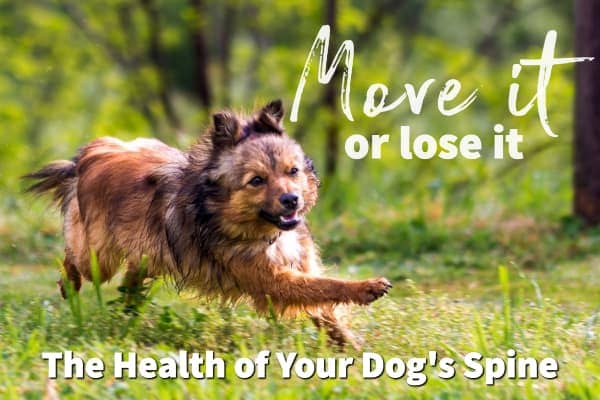
We’ve all heard the expression “move it or lose it” as it applies to our own health. The more physically active we are, the healthier our bodies are. Did you know that the same is true for dogs? And that a dog’s spine plays a key role in your dog’s well-being?
Understanding and managing your dog’s health begins with some basic anatomy and a little science about the way the canine spine replenishes and nourishes itself. By understanding how it works, you can help your dog live the longest, healthiest life possible. Let’s get started!
Dog spine anatomy
First, to understand the role that the spine plays in your dog’s well-being, we need a clear picture of the anatomy of a dog’s spinal column. As you can see in the X-ray below of a dog’s spine, it really is quite amazing in itself.
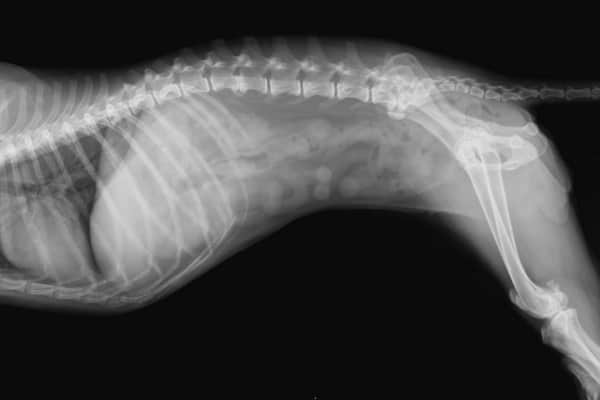
A dog’s spinal column
Nerves
The dog’s spinal column is comprised of numerous nerves each firing information down and up the spinal cord. It keeps your dog’s body safe and operational. These nerves transmit signals for movement and sensation.
Vertebrae
The backbone consists of a series of bones which integrate in a very specific way. Let’s break it down.
Hard bones, called vertebrae, encase the spinal column structure and protect it from injury. The vertebrae create a unique design that allows the body to move and flex. If the dog’s spinal cord were encased in one long, tunnel-like bone, the dog would literally not be able to bend. (Think of a scarecrow or a rigid broomstick.) Thankfully, that’s not the case. Instead, the dog’s spinal cord is very flexible.
As the diagram below shows, there are five regions of vertebrae that make up the dog’s spine (backbone). By looking closely at the diagram, you’ll see dogs have:
- 7 cervical vertebrae
- 13 thoracic vertebrae
- 7 lumbar vertebrae
- Sacrum (3 fused vertebrae)
- Caudal vertebrae (variable number based on tail length)
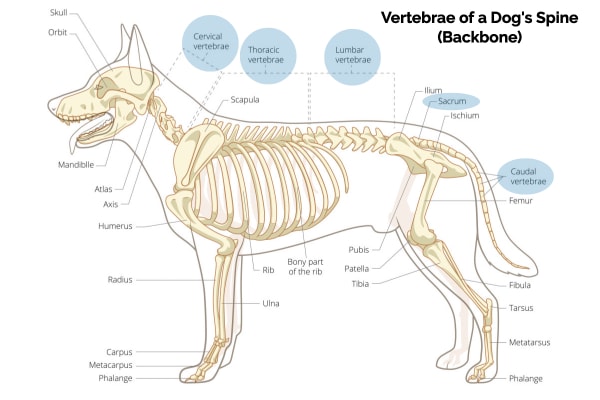
Discs
Next, there are several joints between each vertebra. Each joint is separate and individual. A cartilage disc fits between each joint. In the image below, you can see the vertebrae, how the discs fit between the joints, and how the spinal cord is housed within the them.
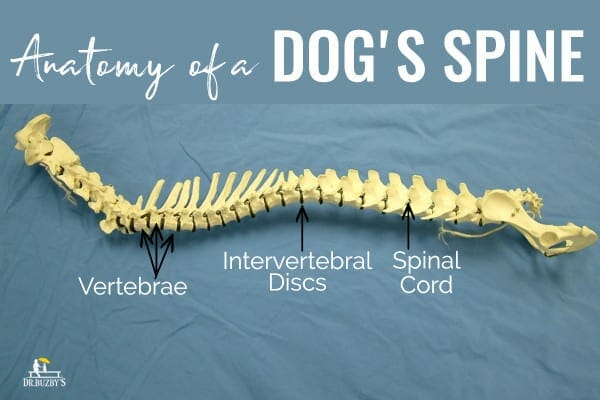
The discs do not have blood vessels in them. However, discs live, and they do a very important job. If your dog (or you) have ever suffered from back pain, you probably know the important role that discs play.
When discs deteriorate: Back pain in dogs
Next, let’s take a look at one of the most common causes of back pain in dogs—intervertebral disc disease. IVDD in dogs is a catchall phrase for disc-related back problems. While Dachshunds are one of the breeds often associated with IVDD, it is common in many breeds.
Intervertebral disc disease
Let’s break down the meaning of intervertebral disc disease by looking at the meaning of each word in the term:
INTER = Between
VERTERBRAL = The two vertebrae (the two bones)
DISC = The shock-absorbing structure
DISEASE = A disorder, something is not right
Essentially, intervertebral disc disease is a problem with the disc. It may bulge out of its normal placement and put pressure on the spinal cord. Or, a disc may completely rupture. (A ligament at the top of the disc can rupture and the disc material can move out of its normal spot, create inflammation, and cause damage to the spinal cord.) This manifests in a variety of degrees of neurologic disease.
A dog may present with the following symptoms:
- Doesn’t walk correctly
- Looks a little bit off balance
- Doesn’t place his or her feet correctly
- In severe cases, paralysis (Read: IVDD in Dogs: Lady Penelope’s Experience)
The health of your dog’s spine
Now that we understand basic dog spine anatomy and what can happen when a dog’s joints deteriorate, let’s take a look at how to keep your dog’s spine healthy.
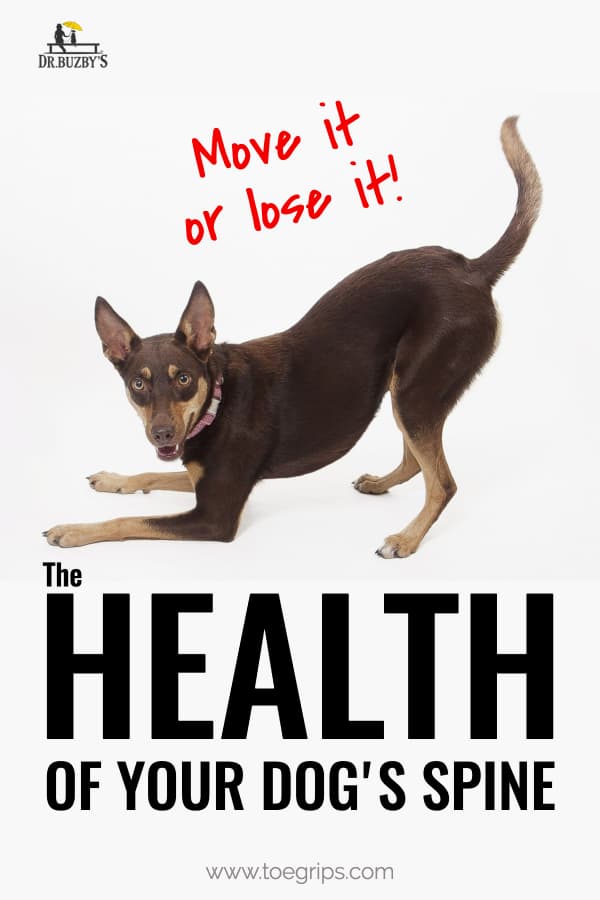
Why mobility is key to your dog’s spinal health
As an integrative veterinarian, I can’t stress enough the importance of mobility. Not only is it key to your dog’s spinal health, but also it’s key to your dog’s overall health.
Dogs were made to move. In the wild, they traveled for miles a day. Mobility is essential to every aspect of your dog’s health: physical, mental, and behavioral. Because dogs walk on four legs rather than two, back flexibility and health is even more important than it is for people.
Additionally, motion (the very act of the body flexing and extending repetitively) is an essential feature in providing nutrition to the discs of the backbone. The term for this is “imbibition.”
Imbibition is the act of the dog’s spine flexing and extending repetitively through movement to provide nutrition to the discs of the backbone.
How to keep the discs in a dog’s spine healthy
Unlike other areas of the dog’s body like the skin and liver that receive nutrients and oxygen through the blood vessels and that carry waste products out of the tissues, the dog’s discs do not contain blood vessels. So how do the discs stay healthy?
Imbibition
That’s where imbibition comes in. Imbibition is the the process of the discs continually being squeezed and then pressure coming off of them (compressing, relaxing, and expanding).
The easiest way to understand imbibition is to picture a sponge immersed in water. Now imagine squeezing the immersed sponge with your hand, squeezing out all the water, and then letting go of the sponge. When you let go, the sponge fills back up with water again. The process, repeated over and over again, is basically the process happening in the discs in imbibition.

Now, let’s apply this same theory to your dog’s spine:
- Every time there’s a movement in your dog’s body, there’s a squeezing and releasing of spinal fluid that the discs are bathed in.
- The nutrients are moving in and out.
- As the spinal fluid is moving out, it’s taking waste products with it.
- This process continues as long as your dog is in motion.
Finally, imagine the sponge submerged in water again. This time your hand isn’t actively squeezing the sponge. The sponge sits in one static position with one static amount of content. There is no change. Using this same analogy, you can deduce why movement is crucial for dogs.
Without movement, a dog’s joints have been scientifically proven to begin deteriorating in less than 24 hours.
From a dog’s joints to muscles to ligaments to mental health and right down to the discs of a dog’s spine, movement is the key to a dog’s life. Mobility is a dog’s greatest asset.
What’s the key takeaway? Take steps now with your dog. Literally. Every step our dogs take with us will be a step in the right direction toward a better quality and quantity of life. Let’s all move it…so that our dogs don’t lose it.
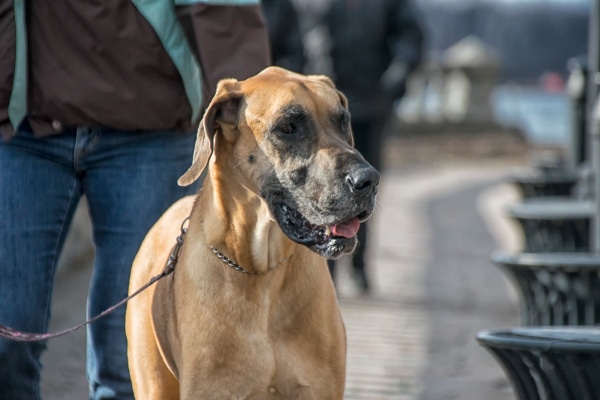
Frequently asked questions about dog spinal health
Finally, I get many questions from my veterinary clients about dog spinal health. You may have some of the same questions, too. Here answers to three common questions:
I can feel my dog’s backbone. Is that normal?
Usually, yes. If your dog’s spine is easily felt with a thin layer of fat, it’s most likely normal and indicates your dog is at a healthy weight. That being said, if your dog’s backbone protrudes, it may be an indication that your dog is on the thin side (depending on breed and conformation).
For more about your dog’s topline (backbone) as an indication of your dog’s body condition score, please check out my article on three easy steps to body condition scoring your dog. Also, it’s always best to check with your veterinarian if you’re concerned about your dog’s health.
If you notice changes to your dog’s backbone, such as vertebrae suddenly appearing more apparent, this may indicate a health concern. Muscle wasting, nutritional issues, metabolic disorders, certain types of cancers, and osteoarthritis in dogs can all make the backbone more visible.
Is a dog’s tail an extension of the spine?
Yes! Interestingly, your dog’s tail is an extension of your dog’s spine. Whether your dog’s tail is long or short, it includes the caudel vertebrae—a region of your dog’s tail that’s part of the spine (backbone).
How can I tell if my dog has back pain?
If you suspect your dog is experiencing back pain, please make an appointment with your vet. He or she is always the best source of information and can accurately diagnose your dog. Your veterinarian may perform a physical and neurological examination to understand the underlying cause. Some of the common signs your dog is experiencing back pain include:
- Hunched posture
- Crying in pain when touched or picked up
- Stiff gait, limping, or dragging back legs
- Muscle spasms or trembling
- Changes in mood or behavior
- Reluctance to jump, run, or climb
- Appetite change
For more information about the canine spine, please listen to my podcast: Move it or Lose It: The Health of Your Dog’s Spine.
What questions do you have about the health of your dog’s spine?
Please comment below.


My 5mo puppy’s dna test came back with two of three genes for future back/disc issues.
How can I prevent this?
What is a healthy spine shape? I find myself staring at his back thinking, is it too curved?
Lol I know it’s making me crazy.
Hi Schuyler,
I understand your concern for your puppy with the genetic results you received. Unfortunately, if your dog is genetically prone to developing back issues, the odds of being able to prevent them are not very good. You may be able to help your pup maintain a healthy spine for as long as possible by making sure he remains in good physical condition. Strong muscles along his back will help offer stability to the spine. Daily exercise and maintaining an ideal weight and body condition will go a long way towards preventing back issues. It is hard to describe the shape of a healthy spine with just words. I recommend you have your pup evaluated by your vet and they can let you know if anything seems abnormal. Try not to stress over the “what ifs” and take things day by day. I am certain you have many happy years ahead.
Dr. Buzby
Where is the location of t-11 to T-12, I just found out Sadie 8yr Doxie has narrowing
of disc betwen these two sections.
Is it bad for our wlking 40 min. twice a day,early morn & late afternoon?
Does laser therapy do any good?
Thank you very much.
Hi Catherine,
This is a great question. The “T” stands for thoracic which is the medical term for the section of your body that contains your chest cavity. There are 13 individual vertebra that make up the thoracic spine. Number 1 is closest to the neck, and they proceed down toward the tail. The spine changes from thoracic to lumbar where the ribs end. So, narrowing at T-11 and 12 would be close to where the ribs end (mid body) and the abdomen (lumbar area) starts. If there has been a recent injury, then it can be best to restrict activity until the inflammation has subsided. But if this is a chronic issue then daily low impact walking is a great thing to help maintain muscle strength and mobility. Laser therapy is great for spinal conditions as long as cancer is not suspected. Hoping Sadie will continue living her best life. Wishing you both many years ahead.
Hello Dr. Buzby! Our 9 yr. Old doodle has some narrowing of the lower vertebrae. He sleeps curled up in a ball and his movement seems worse after he hasn’t been moving for a while. Could this be because of his curled up sleep position, getting up after not moving for a while, or both?
Hi S.,
From what you describe, it sounds like your boy may be experiencing some stiffness that is normal with the aging process (arthritis may also be a possibility). Just like humans, it can take a little bit to get warmed up after resting or sleeping for a while. He may feel stiff and just needs some time to get things stretched out. Even though this is normal as dogs age, your pup may benefit from a medication or supplement that treats arthritis symptoms. Please reach out to your vet as they can help you choose from the MANY options to treat arthritis pain and inflammation.
My dog is a pit bull and for the past month she has been limping on her back right leg she can still run somewhat jump she seems not to be in any pain also her lower spine is kind a protruding out. I don’t know what it could be should I be worried
Hi Jon,
I understand your worry for your girl with these new mobility issues. Any lameness or limping is always a concern. Just because your pup isn’t crying out doesn’t mean she is not painful. Dogs are very good at masking the signs of discomfort. The reluctance to use her leg completely is a sure sign of pain. The only way to figure out what is causing these problems is to have your dog examined by your vet. I highly recommend you schedule an exam so your vet can do some investigating. After identifying the cause, your vet can recommend an appropriate treatment. Best wishes!
My little rescue dog Dottie is very active but rolled and fell off the bed and the next day she was squealing if I touched her, the vet says she has two slimmer discs than the rest ,and that may be the problem . I was hoping it was muscular and that she had twisted herself a bit. She is two and a half and has only yelped about four times since we have had her in 18 months spread over weeks at a time. I was told to rest her and not allow her to move quickly and now i’ve read you say her bones can start to decline in as little as 24 hours, i’m worried about her as she didn’t get a great start in life.
Hi Trudi,
I understand your concern for your little pup and wanting to make sure she is receiving the best of care. If your vet is worried about a disk issue, then yes Dottie should be on strict rest for a while. When we talk about joints declining due to lack of movement, we are talking about complete immobility. As long as Dottie is walking outside to potty and standing to eat and drink, this movement should be sufficient to keep her joints well-nourished while her activity is restricted temporarily. I will attach links to other articles with more information about intervertebral disk disease (IVDD). I hope Dottie will have a complete recovery and be back to her spunky self soon!
1. IVDD in Dogs: Why it Happens
2. IVDD: Can a dog recover without surgery?
3. IVDD Surgery: What If Your Vet Recommends Surgery for Your Dog?
My 11 year old very soul love you Fox Red Labrador was just diagnosed with spondylosis. I’m looking for ways to stimulate her without rough house play or running. And just making her remaining years enjoyable
That should be very sassy and energetic
Hi Tracey,
I am glad you are looking for ways to keep your girl active despite her diagnosis. It would be a good idea to contact a veterinarian that specializes in rehabilitation and physical therapy. They can review your pup’s specific case details and personalize an exercise plan for her. They can follow up to make sure the pain and inflammation are under control and allow her to live a full and happy life. Best wishes!
I have a senior dog who has gotten regular exercise her whole life but I’m having trouble lately. She’s a 75 lb, 14 1/2 yr old Chessie. The day after we go for a short walk (or sometimes that evening) her legs get very tired and her back end gets low to the ground. I give her fish oil, a joimt supplement with glucosamine, msm, etc. We’ve been to the vet but do you have any thoughts as to hoe else I can help her? I realize you might not have all the info or the time to help. Thanks for the article- very informative!
Hello Janell, I love hearing about your senior Chessie because I’m very optimistic that more can be done to help her feel and move better! I would strongly recommend you set up a physical exam for her where the doctor will check her muscles, joints, and also evaluate her neurologically. I think trying to get a handle on the diagnosis is the first step because this will yield the best treatment protocol and a prognosis (meaning the expected outcome). Options from cold laser to acupuncture to Western medications, may all prove very helpful for your dog.